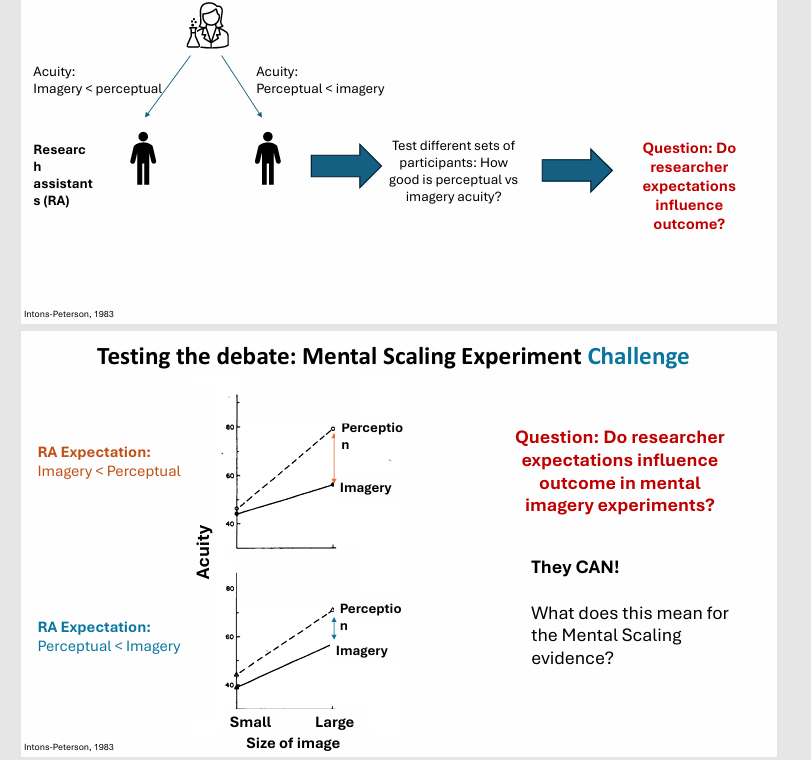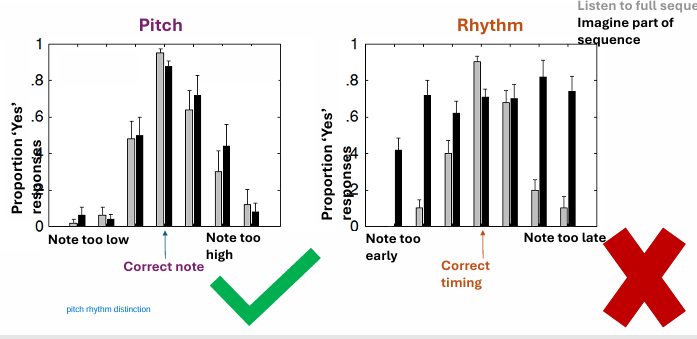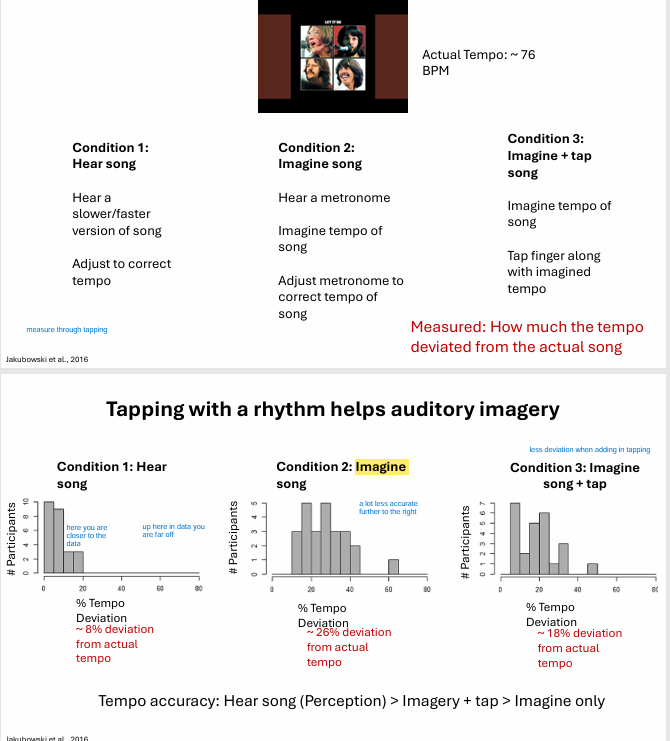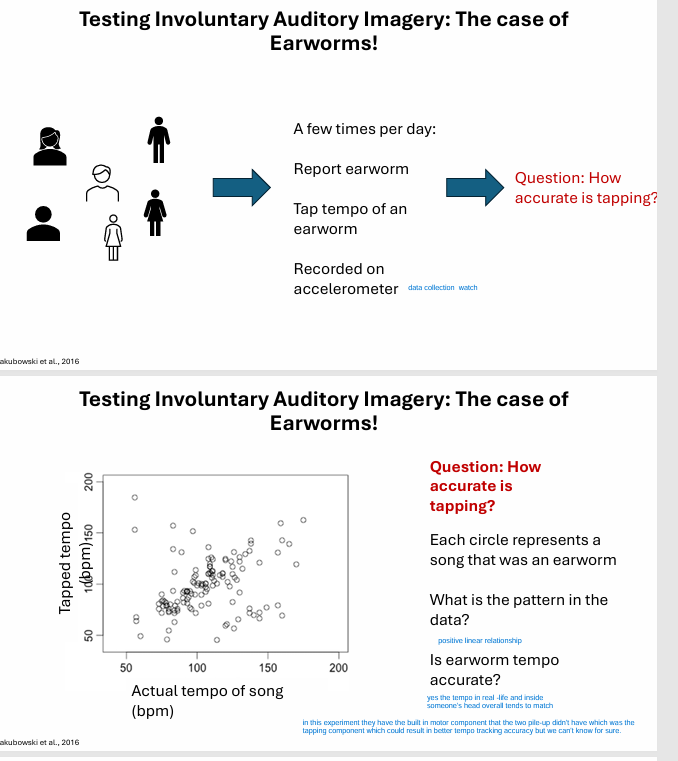Week 10 - Mental Imagery
1/48
There's no tags or description
Looks like no tags are added yet.
Name | Mastery | Learn | Test | Matching | Spaced |
|---|
No study sessions yet.
49 Terms
What is mental imagery?
The ability to imagine, in our mind, some perceptual/sensory experience, without a stimulus present
implies vision, but can be used in touch, smell, and auditory information as well
the ability to imagine things in your mind is not restricted to your visual system
different senses
perceive external world vs. mentally imagine (internally)
Testing for visual mental imagery - Approach 1
Ask questions!
Vividness of visual imagery questionnaire (VVIQ) tests object imagery
ex. give scenario, ask to imagine, ask how vivid the image was in the imagined scenario
Testing for Visual Mental Imagery - Approach 2
make people do a visual mental imagery task and record performance
paper folding task to test spatial imagery
how many correct answers they get basically tells you how good you can mentally picture these images
ex. fold paper and punch a hole, mentally unfold paper: where should the holes be?
Does everyone have mental imagery?
Most people have SOME mental imagery or varying intensity
aphantasia → Phantasia→ Hyperphantasia
not a disorder, but a spectrum of human experience
Aphantasia
no voluntary visual mental imagery
congenital - something you are born with
acquired - happens later in life as you experience things
imagery in dreams - involuntary mental imagery
this could be due to different neural pathways
Phantasia
average mental imagery abilities
Hyperphantasia
vivid visual mental imagery - life-like mental imagery
“real-life” quality to visual images
Mental Imagery Debate
How are mental images represented? what is the code?
Picture-based code (depictive code)
Linguistic-based code (propositional code, “descriptive code”
Depictive coding
all about pictures
‘mental picture’ camp
imagine a visual scene maintaining original spatial relationships
analog code - encoding of mental image maintains properties of environment we see
ex. we see the room when we mentally imagine it again the chairs, couch and table will be in the same spatial relationship to each other

Propositional coding
‘abstract language camp’
abstract propositions store relationships from visual scene
allows for depictive representations to emerge, but not fundamental
ex.
instead of encoding with maintained spatial relationships, we use a code to remember the picture.
here the table is to the left of the chair or the couch is behind the table
we use abstract statements/propositions that contain info from the original image and use that to encode a mental image.
Left (t,c) - table is to the left of the chair
behind (c,t) - couch is behind the table
don’t use the same letter for 2 things that is a bit redundant and confusing"
What do people agree on on regarding mental imagery
people experience mental images!
people do use propositional representation in cognition
mental imagery is not necessarily solely depictive
What do people disagree on regarding mental imagery?
there is a true form of representation - coding
propositional side:
only encode through propositions allowing us to generate images and language (Knowledge→ propositions→ either images or words
Depictive side:
encoding can either be as propositions OR images
(knowledge → images or propositions/words)
Testing the debate: Mental scanning
Scanning = visual scanning - moving our vision/attention around a visual scene
MENTAL SCANNING: scanning image in head, not shown a picture anymore
moving our vision/attention around our mental image
asked to conjure up an image on your own → move attention around mental images
Logic of mental scanning: Depictive support
if mental images are coded as pictures (depictive), then response times on mental scanning tasks should be similar to those of visual scanning tasks
Logic of mental scanning: Propositional side
if mental images are coded as abstract language (propositional) then response times on mental scanning tasks should not be related to those of visual scanning tasks
Mental Scanning - Experiment 1 (Kosslyn 1973)
memorize images
image scan images
record how long it takes to complete each scan
results: it takes longer to scan far images for both visual and mental scans
supports depictive code → truly scan an image in our mind
experiment 1 challenge:
people might be scanning a list of propositions not mental pictures
further items in picture = further items on a list (there may be some spatial properties to your list (think of a car bumper vs. license plate
LONGER mental scanning times are consistent with the propositional side too!
Mental scanning Test: experiment 2
Memorize landmarks on a map
scan between landmarks in mental image
measure: time it takes to scan scene (how long does it take to scan between the cave and the palm tree, this time there is nothing between the landmarks so you can’t order them they are strictly just remembered)
Experiment 2 - results
Same pattern as experiment 1 - far scan takes longer than close scan for both visual and mental scans
small differences; overall doesn’t take longer to visual scan over mental scan
this evidence is for depictive coding meaning we scan pictures in our mind
Testing the debate: mental rotation (collins & Kimura)
rotation in space = turning an object
mental rotation = turning an object in your mind

Mental rotation - depictive support
if you use a depictive code, then the further you have to rotate an object the longer it will take you to mentally rotate an object
Mental rotation: propositional support
if you use a propositional code, then there will be no relationship between how far you have to rotate an object and how long it takes you to mentally rotate an object
Mental Rotation: results
Supports depictive side → suggests we really manipulate pictures in our mind
Mental Scaling
visual scaling = objects change in size and detail depending on how close we are (due to space in the field of view)
mental scaling = imagined objects change in size and detail, dependent on how close/far away we imagine being (mimics field of view changes
Mental Scaling: Depictive support
the further you image being from an object, the smaller and less detailed it is. You need to ‘zoom in’ to get more detail, and this should affect response times
Mental scaling: propositional support
the further you imagine being from an object should not affect object size and detail. no need to ‘zoom in’ to get more detail, response times are unaffected
Mental scaling experiment(Kosslyn, 1975)
smaller animal vs. bigger animal - does it have legs? (use images to answer question)
smaller image response time is greater than larger image response time (need to ‘zoom in’ on the small image to answer the question which takes longer
Mental scaling challenge (Intons - Peterson, 1983)
Demand characteristics: when a participant does something (they think) the experimenter wants them to do (skews the results)
Experimenter expectancy: experimenter’s expectations influence outcome
people DON’T have to zoom in but they can.
Mental scaling - do researchers expectations influence outcome?
They CAN!!

Perception and Imagery interaction? - depictive support
if perception and imagery interact, then they share similar mechanisms and are similar things(pictures)
Perception and Imagery interaction? - propositional support
if perception and imagery do not interact, then they do not share similar mechanisms and are not similar things (propositions)
Perception/Imagery Interference?
do participants detect the stimulus better in the NO interference conditions? YES!
when you have to perceive and imagine something in the same modality, you do worse on the task → shared mechanisms?
Mental scanning RECAP
Depictive side: evidence that we scan pictures in our mind
Propositional side: could be scanning lists in our mind
Mental rotation RECAP
depictive side: evidence we rotate pictures in our mind
Mental scaling RECAP
Depictive side: evidence that we can ‘zoom in’ on pictures in our mind
propositional side: sure, but do we have to? demand characteristics/expectations from researcher that skews data…
Perception-Imagery interaction RECAP
Depictive side: perception and imagery can interfere with one another
Mental Imagery Debate Conclusion
still debates about depictive vs. propositional as the fundamental coding of mental imagery - keep researching!
Falsification - evidence FOR a theory does not guarantee the truth. Falsification tries to show that things are NOT the case (do not prove that things ARE the case)

Mental Imagery can help memory: Dual coding theory
can code things in pictures and/or language
dual coding = better memory
dual coding states we can create a picture AND a linguistic label for concrete words, but only a single linguistic label for abstract words
Mental Imagery can help memory: Concreteness effect
memory is better for concrete(more common) words (like tree and book) than abstract (less common) words (like hope and quest)
Voluntary Auditory Imagery
asked to imagine a song or a rhythm - hear notes in your mind
Involuntary auditory imagery
songs/rhythms get stuck in your head
hear the notes in your mind → hard to stop
earworms (constantly play music)
Traditional probe ton technique
play a sequence of tones → pause → play a single tone
participant states whether tone was correct or not
participant states whether the timing of the tone was correct in the sequence
Imagery probe tone technique
play a few tones → imagine tones → single probe tone
was tone correct in sequence?
was timing of tone correct in sequence?
How good are people at imagining tone and pitch? (Janata & Paroo 2006)
pitch = good
rhythm = bad

how to help imagine rhythm timing?
motor system
move a lot to music, so maybe when we move AND imagine rhythms we get better at imagining the timing of rhythms - can connect it more because of the movement

Earworms
lots of people report earworms
tend to resemble familiar music, but can be novel (musicians/composers)
Testing Earworms: (Jakubowski et al. 2016)
ear worm tempo is accurate with actual tempo of song - positive linear relationship

Auditory image takeaways
it exists! : can be voluntary or involuntary
better at ‘hearing’ pitch inside our heads rather than rhythm - BUT it depends on if we engage the motor system or not
earworms sound like real music -familiarity effects
Mental Imagery takeaways
It exists! - on a continuum (Aphantasia → Phantasia → Hyperphantasia)
DEBATE: evidence for/against depictive and propositional - need more evidence
Mental imagery interacts with other aspects of cognition - memory (find other textbook examples)